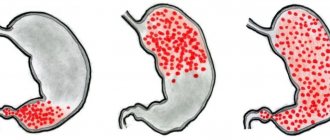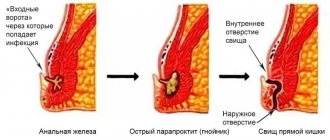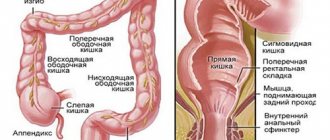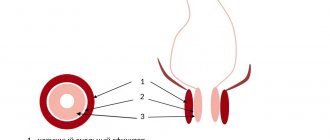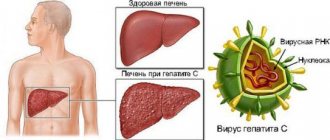What is papillitis
In medicine, papillitis is an inflammation of benign formations on the mucous membrane of the rectum along the anorectal line. They are located at the edges of the semilunar valves surrounding the Morgani crypt and columns. The shape of the formations can be different: on a wide base with a narrow apex (triangular) or on a narrow base with a spherical apex. Normally, they look like pinkish dense nodules, but under certain circumstances they can increase in size (the so-called hypertrophy of the anal papillae occurs). In this case, the papillae can become so large that they fall out of the anal canal.
With prolonged traumatic effects on the anal papillae, they become inflamed, swollen and painful. In some cases, ulcers or erosions appear at their apex. All this is accompanied by extremely unpleasant symptoms, similar to the manifestations of hemorrhoids and other diseases of the rectum.
Classification
According to their structure, gastric papillomas are divided into hard and soft, stalked and plantar.
It is also customary to highlight:
- papillomas, located like cerebral convolutions and accumulating as if growing in one ridge;
- pedunculated papillomas, located singly or in groups.
Classification according to clinical course:
- asymptomatic form;
- anemic form;
- gastritis form;
- complicated form;
- combined form.
Causes
Inflammation of papillae occurs for various reasons. Papillitis can be provoked by:
- regular stool disorders (constipation and diarrhea equally);
- unjustified use of enemas;
- lack of physical activity, sedentary lifestyle;
- chemical damage to the anal papillae due to frequent use of rectal suppositories, including those purchased at a pharmacy or made independently according to traditional medicine recipes;
- diseases of the rectum (internal and external hemorrhoids, cryptitis, proctitis and others).
The most common cause of papillitis is proctitis, an inflammatory process on the mucous membrane of the rectum. This disease can be caused by infections (gonorrhea, tuberculosis, staphylococcus, chlamydia, herpes and others), injuries to the rectal mucosa.
Also, papillitis against the background of proctitis can occur due to certain diseases of the internal organs. In particular, doctors associate these diseases with certain forms of hepatitis, cirrhosis, dysbacteriosis, gastritis and peptic ulcers. Also, papillitis often develops against the background of cryptitis - inflammation of the Morganian crypt.
In some cases, the cause of papillitis cannot be determined, which somewhat complicates the process of diagnosis and treatment.
Gingivitis
Gingivitis is an inflammatory disease of the gums that can occur in acute or chronic form. The disease is very common, sometimes patients may not be aware of its existence. Gingivitis occurs due to various reasons and has several forms of manifestation. The pathology is characterized by redness of the marginal edge of the gums, swelling, and pain.
Types of gingivitis
There are several types of diseases. According to the form of the inflammatory process, gingivitis can be acute and chronic, while the chronic form can periodically worsen. If the inflammatory process covers one or more adjacent teeth, then we are talking about a localized form of the disease, but if the process has spread throughout the entire oral cavity, it is a generalized form.
Depending on the type of pathological process, the disease can be catarrhal, ulcerative, atrophic and hypertrophic. The disease can manifest itself in severe or mild form, each type of gingivitis has its own distinctive symptoms and manifestations.
Symptoms of gingivitis
Symptoms of gingivitis will depend on the type and nature of the soft tissue damage.
The catarrhal form of the disease is manifested by redness, swelling, pain and bleeding of the gums. An unpleasant odor, increased temperature, disruption of food intake and distortion of taste sensations may also appear.
Atrophic gingivitis is characterized by inflammation and reduction in the volume of the gums and gingival papillae. Symptoms are unpleasant and painful sensations in the affected area.
Hypertrophic gingivitis is manifested by a significant increase in tissue volume and overlap of tooth crowns. The disease is chronic in nature and has few clinical manifestations.
The ulcerative form of the disease is characterized by the formation of painful ulcers on the gums. In this case, manifestations occur not only in the oral cavity, but also in the body (fever, weakness). This type of gingivitis occurs in people with reduced immunity.
Treatment of gingivitis
Symptoms and treatment of gingivitis will depend on the form of the disease, severity, location and individual manifestations. Therapy should be carried out by a specialist after examination and diagnosis. Treatment of gingivitis consists of the following stages:
Determining and eliminating the cause of the disease;
Professional oral hygiene;
The use of anti-inflammatory drugs (ointments, gels, solutions);
Use of antibacterial therapy;
Taking vitamins and a balanced diet is recommended;
If necessary, surgical interventions are used.
Symptoms and signs of papillitis
When papillitis occurs in the rectum, the clinical picture is similar to hemorrhoids and anal fissure; the patient complains of the following unpleasant symptoms:
- pain in the anus, which may occur when visiting the toilet or at rest;
- false urge to go to the toilet due to the sensation of a foreign object in the anus;
- bleeding from the anus;
- mucus secretion;
- swelling of the anal folds;
- itching and burning of the anus;
- leakage of rectal contents.
Since the symptoms of the disease do not directly indicate papillitis, differential diagnosis will be required, that is, an examination during which diseases that have a similar clinical picture will be excluded.
Types of diseases
>
Inflammatory gum diseases can be of several types:
Papillitis - inflammation of the interdental papilla;
Gingivitis is inflammation of the soft tissues of the gums without disruption of the periodontal junction;
Periodontitis is inflammation of the periodontium - all the tissues that surround and hold the tooth in the bone;
Periodontal disease is a dystrophic-inflammatory disease of soft tissues, which is characterized by tissue atrophy and causes tooth loss;
Idiopathic periodontal diseases, which are accompanied by tissue lysis;
Periodontomas – the appearance of neoplasms and tumor-like processes in the periodontium;
Flux (fistula) is a formation on the gum that occurs as a result of chronic periodontitis and through which purulent contents come out.
Diagnosis of papillitis
For an initial diagnosis of symptoms of papillitis, you should contact a coloproctologist. To begin with, an anamnesis will be collected and a digital examination of the rectum will be performed, as well as a detailed survey regarding symptoms, the time of its onset and other features.
Laboratory diagnostics with examination of blood, feces and urine for suspected papillitis are rarely carried out. The basis of diagnostic measures are instrumental studies:
- anoscopy;
- sigmoidoscopy;
- video colonoscopy;
- X-ray of the intestine with contrast;
- Ultrasound of the abdominal organs.
During instrumental studies, the doctor can take biological material (biopsy) for microscopic examination of tumors.
When making a diagnosis, the coloproctologist will have to exclude neoplasms that are similar in appearance and symptoms: sentinel tubercles in chronic anal fissure or rectal polyps.
Treatment of papillitis
Treatment for papillitis is required if the size of the anal papillae exceeds 10 mm. In this case, they are physically felt by the patient, even in the absence of inflammation, as a foreign object in the anus. If the size of the tumors is small and they do not cause any discomfort, specific therapy is not required.
The treatment tactics for hypertrophied anal papillae depend on the prevalence of the inflammatory process, the number and size of papillae. With a slight increase in inflamed papillae, conservative treatment is sufficient. For this, local remedies are used - baths, enemas, compresses and ointments with anti-inflammatory, antiseptic and astringent effects. The purpose of using the funds is to eliminate the inflammatory process.
For constipation, laxatives or enemas are additionally used, proper nutrition is organized to promote normal functioning of the gastrointestinal tract:
- exclude fatty and sweet foods;
- refuse spicy and salty foods, spices and sauces with vinegar;
- exclude alcohol and carbonated drinks.
The menu should consist mainly of boiled or stewed meat (preferably white), cereals, vegetables, fruits and berries. Ready-made meals should not contain solid fragments that are difficult to digest and theoretically can injure the mucous membranes of the intestines and rectum. The preferred method of preparing dishes is regular boiling or in a double boiler.
In case of a complicated course of the disease, large size of tumors and spread of the inflammatory process to surrounding tissues, surgical treatment may be required. It is performed on the rectum under local anesthesia. The doctor excises the inflamed papillae and coagulates (cauterizes) the wounds to prevent bleeding. Cryodestruction of tumors can also be used.
For 2 weeks after removal of papillae, avoid any physical activity. On the first day, meals include light broths, vegetable and fruit purees. In the future, the most gentle diet is recommended, consisting of boiled and stewed vegetables, lean meat, porridge with water or milk from cereals.
Important! During the recovery period after removal of anal papillae, it is not recommended to use cleansing enemas, rectal suppositories, or engage in anal sex.
Medicines
For small growths, it is sufficient to use medications that increase immunity. For single papillomas in the stomach, the following is prescribed:
Antiviral agents:
- Isoprinosine;
- Reaferon;
- Acyclovir;
Anti-inflammatory drugs:
- Panavir;
- Viferon;
Immunomodulatory drugs:
- Interferon;
- Galavit;
- Pentoxyl;
- Lycopid;
Multivitamin complexes:
- Alphabet;
- Vitrum;
- Revivona;
Herbal tinctures:
- lemongrass;
- Eleutherococcus;
- rose hip.
Prevention of exacerbations
According to statistics, papillitis often bothers older people and those who have bad habits. The disease can also worsen with a decrease in immunity, deterioration in the quality of nutrition and insufficient physical activity. Therefore, to prevent the disease, doctors recommend giving up smoking and alcohol, diversifying your diet as much as possible, eating regularly and nutritiously, moving more and walking in the fresh air.
Since exacerbation of the disease can be caused by the influence of chemicals on the mucous membranes, you should be careful when taking medications that irritate the gastrointestinal tract. If papillitis has been diagnosed and treated, patients should be regularly examined by a coloproctologist.
